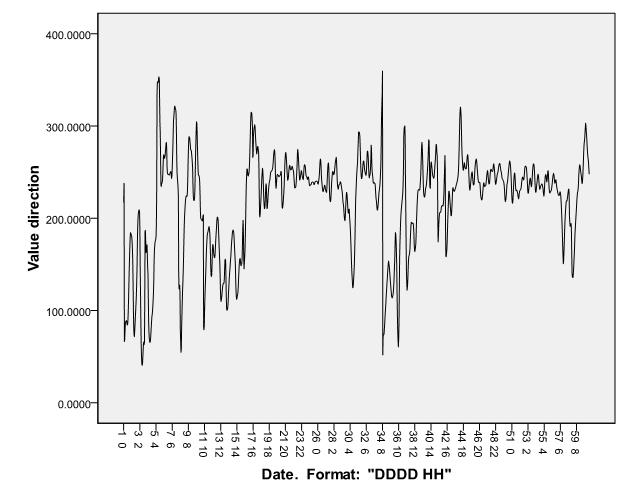การเปรียบเทียบวิธีการพยากรณ์ทิศทางลมที่ระดับความสูง 120 เมตร จังหวัดนครศรีธรรมราช
Main Article Content
Abstract
Warangkhana Riansut
รับบทความ: 4 กันยายน 2562; แก้ไขบทความ: 17 ธันวาคม 2562; ยอมรับตีพิมพ์: 14 มกราคม 2563
บทคัดย่อ
งานวิจัยนี้มีวัตถุประสงค์เพื่อเปรียบเทียบวิธีการพยากรณ์ทิศทางลม 5 วิธี คือ วิธีบ็อกซ์–เจนกินส์ วิธีการทำให้เรียบแบบเลขชี้กำลังของโฮลต์ วิธีการทำให้เรียบแบบเลขชี้กำลังของบราวน์ วิธีการทำให้เรียบแบบเลขชี้กำลังที่มีแนวโน้มแบบแดม และวิธีการพยากรณ์รวม อนุกรมเวลาทิศทางลมรายชั่วโมงที่ระดับความสูง 120 เมตร จากจังหวัดนครศรีธรรมราชได้มาจากศูนย์วิจัยพลังงานและสิ่งแวดล้อม มหาวิทยาลัยทักษิณ ตั้งแต่วันที่ 1 พฤษภาคมถึงวันที่ 1 กรกฎาคม 2558 จำนวน 1,465 ค่า สำหรับการเปรียบเทียบความเหมาะสมของตัวแบบพยากรณ์จะใช้เกณฑ์ร้อยละความคลาดเคลื่อนสัมบูรณ์เฉลี่ยและเกณฑ์รากที่สองของความคลาดเคลื่อนกำลังสองเฉลี่ยที่ต่ำที่สุด ผลการศึกษาพบว่า วิธีการทำให้เรียบแบบเลขชี้กำลังของโฮลต์มีความเหมาะสมมากที่สุด
คำสำคัญ: ทิศทางลม ตัวแบบพยากรณ์ บ็อกซ์–เจนกินส์ การทำให้เรียบแบบเลขชี้กำลัง การพยากรณ์รวม
Abstract
This research aimed to compare five methods of forecasting wind direction: Box–Jenkins method, Holt’s exponential smoothing method, Brown’s exponential smoothing method, damped trend exponential smoothing method, and combination forecasting method. Time series of hourly wind direction at an altitude of 120 meters in Nakhon Si Thammarat province were gathered from research center in energy and environment, Thaksin University during 1 May to 1 July 2015 of 1,465 observations. The criteria of the lowest mean absolute percentage error and root mean squared error were used for comparing the suitability of the forecasting model. The study indicated that Holt’s exponential smoothing method was the most appropriate.
Keywords: Wind direction, Forecasting model, Box–Jenkins, Exponential smoothing, Combined forecasting
Downloads
Article Details

This work is licensed under a Creative Commons Attribution-NonCommercial 4.0 International License.
References
Bielecki, M. F., Kemper, J. J., and Acker, T. L. (2014). Statistical Characterization of Errors in Wind Power Forecasting. USA: Northern Arizona University.
Box, G. E. P., Jenkins, G. M., and Reinsel, G. C. (1994). Time Series Analysis: Forecasting and Control. 3rd ed. New Jersey: Prentice Hall.
Keerativibool, W., Waewsak, J., and Kanjnasamranwong P. (2011, May). Short–term forecast of wind speed at Chana district, Songkhla province, Thailand. Proceedings of the 2011 International Conference on Alternative Energy in Developing Countries and Emerging Economies (pp. 343–350). Hat Yai, Thailand.
Ket–iam, S. (2005). Forecasting Technique. 2nd ed. Songkhla: Thaksin University. (in Thai)
Manmin, M. (2006). Time Series and Forecasting. Bangkok: Foreprinting. (in Thai)
Mauch, B. K. 2012. Managing Wind Power Forecast Uncertainty in Electric Grids. Ph.D. dissertation. USA: Carnegie Mellon University.
Montgomery, D. C., Peck, E. A., and Vining, G. G. (2006). Introduction to Linear Regression Analysis. 4th ed. New York: John Wiley and Sons.
Promdee, C. (2016). Electric Power Generation of Savonius Wind Turbine with Double Wind Tunnels. Master of Electrical and Computer Engineering Thesis. Mahasarakham: Mahasarakham University. (in Thai)
Thongyai, N., and Assawamartbunlue, K. (2017). Wind atlas simulation to find wind potential area to generate electric power of the Chanthaburi and Trat Provinces, Thailand. Proceedings of the 31st Conference of Mechanical Engineering Network of Thailand (pp.737–745). Nakhon Nayok: Phukhaongam Resort. (in Thai)
Vasilji, J., Sarajcev, P., and Jakus, D. (2015). Wind Power Forecast Error Simulation Model. World Academy of Science, Engineering and Technology International Journal of Electrical and Computer Engineering 9(2): 138–143.
